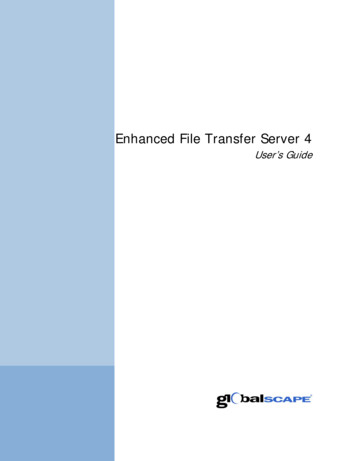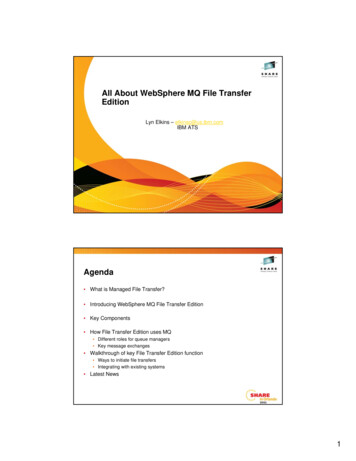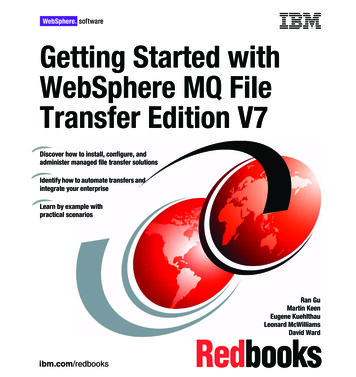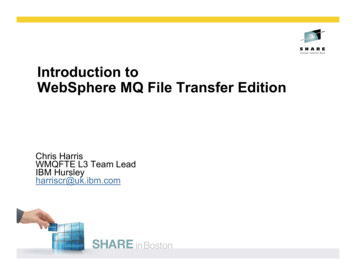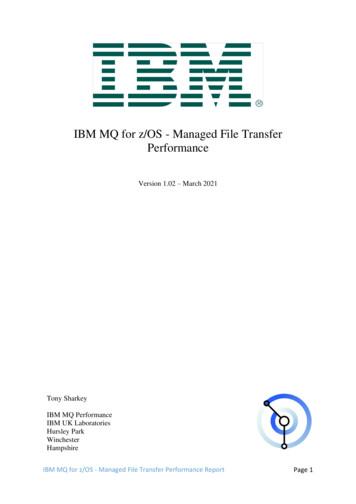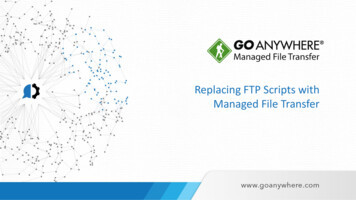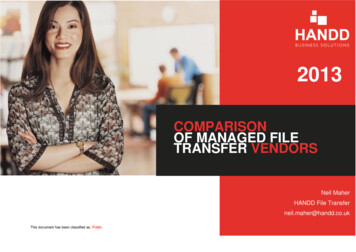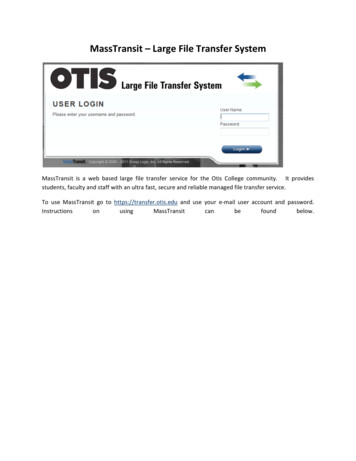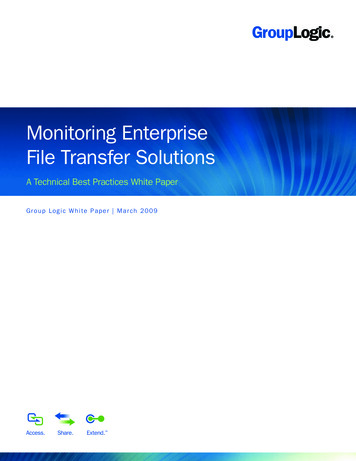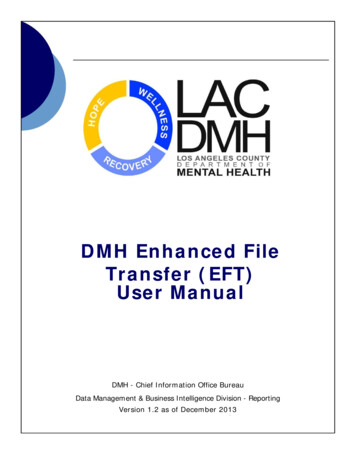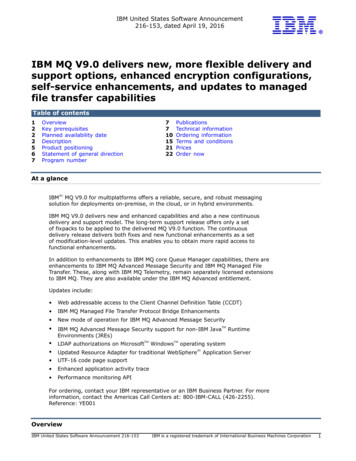
Transcription
IBM United States Software Announcement216-153, dated April 19, 2016IBM MQ V9.0 delivers new, more flexible delivery andsupport options, enhanced encryption configurations,self-service enhancements, and updates to managedfile transfer capabilitiesTable of contents1222567OverviewKey prerequisitesPlanned availability dateDescriptionProduct positioningStatement of general directionProgram number7710152122PublicationsTechnical informationOrdering informationTerms and conditionsPricesOrder nowAt a glanceIBM MQ V9.0 for multiplatforms offers a reliable, secure, and robust messagingsolution for deployments on-premise, in the cloud, or in hybrid environments.(R)IBM MQ V9.0 delivers new and enhanced capabilities and also a new continuousdelivery and support model. The long-term support release offers only a setof fixpacks to be applied to the delivered MQ V9.0 function. The continuousdelivery release delivers both fixes and new functional enhancements as a setof modification-level updates. This enables you to obtain more rapid access tofunctional enhancements.In addition to enhancements to IBM MQ core Queue Manager capabilities, there areenhancements to IBM MQ Advanced Message Security and IBM MQ Managed FileTransfer. These, along with IBM MQ Telemetry, remain separately licensed extensionsto IBM MQ. They are also available under the IBM MQ Advanced entitlement.Updates include: Web addressable access to the Client Channel Definition Table (CCDT) IBM MQ Managed File Transfer Protocol Bridge Enhancements New mode of operation for IBM MQ Advanced Message Security IBM MQ Advanced Message Security support for non-IBM JavaEnvironments (JREs) LDAP authorizations on Microsoft Updated Resource Adapter for traditional WebSphereUTF-16 code page support Enhanced application activity trace Performance monitoring APITMWindowsTMTMRuntimeoperating system(R)Application ServerFor ordering, contact your IBM representative or an IBM Business Partner. For moreinformation, contact the Americas Call Centers at: 800-IBM-CALL (426-2255).Reference: YE001OverviewIBM United States Software Announcement 216-153IBM is a registered trademark of International Business Machines Corporation1
IBM MQ V9.0 for multiplatforms is a robust and secure messaging middlewareofferingthat allows applications, systems, services, and files to exchange datarapidly and reliably. For more than 20 years, IBM has led the market in messagingmiddleware, with more than 10,000 businesses across all geographies and industriesthat rely on IBM MQ.IBM MQ V9.0 builds on the functions and capabilities that were added in previousreleases of: IBM MQ IBM WebSphere MQ IBM WebSphere MQ Advanced IBM WebSphere MQ Advanced Message Security IBM WebSphere MQ Managed File Transfer IBM WebSphere MQ TelemetryClients with an active license can obtain the new and enhanced functions that areoffered in IBM MQ V8 by migrating directly to Version 9.0 from WebSphere IBM MQV7.1, V7.5, or V8.0, without migrating to an interim version or release.IBM MQ V9.0 represents the first release of a new way that IBM MQ is brought tomarket and supported. From this version of IBM MQ onwards, IBM offers a newdelivery and support model that separates out the delivery of defect fixes from anynew function. Licensed clients of IBM MQ offerings can choose to consume IBM MQthrough a long term support model that contains the latest features at the timeof general availability, with only defect fixes provided during the support cycle. Anadditional choice of a continuous delivery model is offered, where new function isdelivered incrementally alongside defect fixes in much more frequent modificationlevel updates. To maintain support, clients on this continuous delivery model willneed to keep their IBM MQ environment up-to-date with the continuous delivery ofmodification levels rather than the long term support fixpacks.Key prerequisitesFor details of hardware and software requirements, refer to the Technicalinformation section.Planned availability date June 2, 2016 (Electronic software delivery) June 17, 2016 (Physical media)DescriptionThe initial delivery of IBM MQ V9 provides the basis for both the ongoing, longterm support stream, and also the base for additional function that will be added infuture modification-level updates. The key features of IBM MQ V9 provide additionalvaluable enhancements, but also provide the basis for future enhancements as partof the continuous delivery stream of updates.Updates in the initial Version 9.0 offering enhance the core IBM MQ functions witha number of common enhancements. These apply across all platforms and providethe foundation for ongoing work to enhance self-service operation for IBM MQdeployments, as well as a number of key customer-driven request for enhancements(RFEs).IBM United States Software Announcement 216-153IBM is a registered trademark of International Business Machines Corporation2
In addition to enhancing IBM MQ core Queue Manager capabilities, there areenhancements to the IBM MQ Advanced Message Security capability and the IBMMQ Managed File Transfer capability. These, along with IBM MQ Telemetry, remainseparately licensed extensions to IBM MQ, or available as the bundled IBM MQAdvanced entitlement.These updates support many of the key deliverables that comprise the IBM MQV9.0 offering. Central in this offering is IBM MQ Advanced V9.0, which providescombined entitlement to all the core functions and capabilities that are delivered bythe offering, without requiring additional separate entitlements for each chargeablecomponent. The separately chargeable components available in IBM MQ Advancedinclude: IBM MQ, which provides the enterprise messaging infrastructure. IBM MQ Advanced Message Security, which provides policy-based, end-to-endencryption of the message contents.IBM MQ Telemetry, which provides lightweight, scalable connectivity to IBM MQTelemetry Transport (IBM MQTT)-connected clients and devices.IBM MQ Managed File Transfer, which allows data held in the file system to bemoved over the IBM MQ network for enhanced reliability and security. It offersboth a file-to-file transfer mode and also file-to-message and message-to-filetransfer modes. An additional option is to deploy IBM MQ on the IBM MQ Appliance. See theStatement of general direction section for details on the availability of IBM MQ V9 onthe IBM MQ Appliance.Enhancements to IBM MQ V9.0Operational practices for deployment, configuration, and use of IBM MQ reflect thedifferent approaches seen in varying cloud environments. They are also in demandTMfor use in non-cloud environments. An IBM Redpaper publication, entitled IBM MQas a Service: A Practical Approach, addresses some of the ways in which this can beaccomplished with the product today.IBM MQ V9.0 approaches this movement towards cloud-style manageability byenhancing the product to offer the initial delivery of more self-service functions.The initial step in this process is an update to the Client Connectivity DefinitionTable (CCDT). These have previously only been accessible through IBM MQ toolingand with specific knowledge. IBM MQ V9 improves the ability for clients to remainconnected to MQ Queue Managers by hosting the CCDT in a central locationaccessible through a URI by removing the need to individually update the CCDT foreach deployed client.In IBM MQ V8.0, support was added for JMS 2.0. At that time, WebSphereApplication Server did not support JMS 2.0 and therefore, the Resource Adapter,which supported JMS 2.0 in IBM MQ V8.0, was not at the correct level forWebSphere Application Server. IBM MQ V9.0 delivers an updated version of theResource Adapter to work with traditional WebSphere Application Server.IBM MQ V8.0 added support for the LDAP authentication and also LDAP authorizationon Unix platforms. IBM MQ V9.0 adds support for LDAP authorization on MicrosoftWindows.IBM MQ V9.0 also adds support for UTF-16 code page conversions.An enhanced application activity trace provides an improved mechanism for deepmonitoring and inspection of message traffic. The process is simplified with a newpublish-subscribe API.Performance monitoring using the publish-subscribe API for queue managerstatistics collection gives access for the first time to detailed information such asAPI, IO, and hardware resource usage at a per-object or per-queue manager level.IBM United States Software Announcement 216-153IBM is a registered trademark of International Business Machines Corporation3
Enhancements to IBM MQ Advanced Message SecurityPrevious versions of IBM MQ Advanced Message Security (working with IBM MQV7.0.1, IBM MQ V7.5, and IBM MQ V8.0) had restrictions on what Java RuntimeEnvironments (JRE) could be used. In these environments, Java and JMS bindingsapplications were not affected because they used native cryptographic libraries, such(R)as GSKit or z/OS System SSL. However, the cryptographic libraries that provideddigital signing and encryption were only provided in IBM JRE. This was problematicfor environments where IBM JRE could not be used, such as with applications thatwere only certified for an Oracle JRE. Mitigation was the MCA intercept feature,which was added in the IBM MQ Advanced Message Security in IBM MQ V7.5 thatmoved encryption from the IBM MQ client to the IBM MQ server. This was not idealin terms of performance and weakened the end-to-end benefits of IBM MQ AdvancedMessage Security.In IBM MQ V9.0, JMS clients provide their own cryptographic libraries, whichwork under any JRE supported by IBM MQ. For example, by using Open SourceBouncyCastle crypto API in IBM MQ V9.0, JMS client applications no longer need tobe run under an IBM JRE to take advantage of IBM MQ Advanced Message Security.IBM MQ Advanced Message Security and its predecessor IBM MQ Extended SecurityEdition have always provided two levels of protection Integrity (digital signing only) Privacy (digital signing and encryption)IBM MQ Advanced Message Security uses PKCS#7 format to protect data. A digitalsignature requires an asymmetric key operation to sign the hash. This proves themessage origin and ensures that nobody has tampered with the content. A furtherasymmetric key operation is required to validate the signed hash when getting themessage with the encrypted contents. For encryption, each and every messagegets a new symmetric key. That symmetric key is encrypted for each recipient withan asymmetric key operation. A recipient requires an asymmetric key operation todiscover the symmetric key that was used.This requires a lot of asymmetric key operations, which are expensive in terms ofCPU cycles. This impacts message throughput and workload. Integrity and privacypolicies incur multiple, asymmetric key operations per message. These operationscan therefore quickly become a bottleneck for applications that need to put andget more than a few hundred messages per second. To complement integrity andprivacy policies, a new, third alternative, Confidentiality (Encryption only withoptional key reuse), is provided by IBM MQ Advanced Message Security in IBM MQV9.0.This new mode of operation continues to use PKCS#7 to share a symmetricencryption key. However, there is no digital signature, which eliminates some ofthe per message asymmetric key operations. The symmetric key still needs to beencrypted with asymmetric key operations for each recipient, but the symmetrickey can be optionally reused over multiple messages that are destined for the samerecipients. If key reuse is permitted by policy, then only the first message requiresasymmetric key operations. Subsequent messages only need to use symmetric keyoperations.Symmetric key reuse is conceptually similar to the way in which SSL-TLS sessionswork. In these sessions, the initial labor intensive asymmetric key operations areused in the handshake. And then after the handshake is complete, the session keyis used to securely exchange data using symmetric key. Significant CPU cost savingscan be made with confidentiality policies through symmetric key reuse, which isconfigured using the new -k parameter on setmqspl.Enhancements in IBM MQ Managed File TransferIBM MQ is frequently used in conjunction with its Managed File Transfer extensionand is available either as a separate license or as part of the IBM MQ Advancedoffering. One of the key features of IBM MQ Managed File Transfer is the abilityIBM United States Software Announcement 216-153IBM is a registered trademark of International Business Machines Corporation4
to intercept existing FTP flows with the included FTP protocol bridge function. TheIBM MQ Managed File Transfer function in IBM MQ V9 enhances this protocol bridgecapability in a number of ways: A comprehensive coverage of FTP errors aids problem diagnosis when errorsoccur in this area.A more extensive logging of FTP communications provides additional insight andaid operations.Accessibility by people with disabilitiesA US Section 508 Voluntary Product Accessibility Template (VPAT) containing detailson accessibility compliance can be found on the IBM Accessibility website.Section 508 of the US Rehabilitation ActIBM MQ V9.0 is capable as of June 2, 2016, when used in accordance withassociated IBM documentation, of satisfying the applicable requirements of Section508 of the Rehabilitation Act, provided that any assistive technology used with theproduct properly interoperates with it.U.S. Section 508 Voluntary Product Accessibility Template (VPAT) contains details onaccessibility compliance.Product positioningWhile there are many products or components in the market that claim to providemessaging, only IBM MQ has more than 20 years of experience of providing acomprehensive, robust, and secure enterprise messaging solution, that is suitablefor all types of business-critical transactional and non-transactional messaging.Most other messaging solutions are either not scalable, not as secure, or are verysimplified and cannot be used to the same extent as IBM MQ.IBM MQ can help organizations get more from their IT investments by offeringa reliable and flexible integration backbone for exchanging messages betweenapplications and web services. The core of application integration, delivers the reliable and proven messagingbackbone for service-oriented architecture (SOA) connectivity, as the universal,multipurpose data transport. It connects many commercial IT systems, withsupport for more than 80 platform configurations.–Supports industry-standard JMS 2.0 messaging and offers a choice of APIs.–Interoperates with the JMS messaging services which enables Java EEenvironments to bridge to other environments.Delivers a flexible connectivity solution that can grow incrementally withchanging business needs.– IBM MQ for z/OS exploits the capabilities of the IBM z Systems platform todeliver a messaging powerhouse.IBM WebSphere MQ for HP OpenVMS, WebSphere MQ for HP NonStop Server,(R)and WebSphere MQ for z/VSE all extend the reach of IBM MQ to these specificcomputing platforms.IBM MQ Advanced Message Security expands the industry-standard securitythat is supplied by IBM MQ with end-to-end data protection for applications.It enables enterprise-wide, remote management of security policies on an MQnetwork and can be deployed to existing production environments withoutchanges to existing IBM MQ applications. This capability is integrated into IBMMQ V8 on all supported platforms but is separately licensed for definition and useof policies. Licensing is included in IBM MQ Advanced.IBM MQ Managed File Transfer Service and IBM MQ Managed File TransferAgents leverage both existing messaging infrastructures to provide reliable,secure managed file transfer between systems without major recoding of(R)IBM United States Software Announcement 216-153TMIBM is a registered trademark of International Business Machines Corporation5
applications that produce and consume files instead of messages. Licensing forIBM MQ Managed File Transfer is subject to entitlement in addition to IBM MQentitlement, but licensing for IBM MQ Managed File Transfer Service is included inIBM MQ Advanced entitlement.IBM MQ Telemetry provides a lightweight client to run on physical devices, suchas sensors, or mobile devices (mobile phones), which extends the reach of theIBM MQ infrastructure. Connectivity to MQTT clients or the IBM MQ TelemetryDaemon for Devices is available subject to separate entitlement. Included withentitlement to IBM MQ Advanced is entitlement to deploy IBM MQ Telemetry onall supported MQ servers in the enterprise.WebSphere MQ Low Latency Messaging (on Linux , Microsoft Windows, andOracle Solaris platforms) extends the IBM MQ product family with low-latency,high-throughput delivery. It is optimized for the high-volume, low-latencyrequirements typical of financial market firms and other industries where speedof data delivery is paramount. This is not provided with IBM MQ, but is availableseparately with separate entitlement. Messages can be exchanged both waysbetween IBM MQ and WebSphere MQ Low Latency Messaging.TMIBM MQ delivers the messaging backbone that underpins and extends the IBM ESBportfolio. It supplies the transport layer that ESBs can build upon, to augment thebackbone with mediation, transformation, and routing services. IBM Integration Busadds transformation, intelligent routing, and information flow modeling to the IBMMQ messaging backbone. This ESB distributes information and data generated bybusiness events in real time to people, applications, and devices throughout theextended enterprise and beyond.The IBM MQ family is complemented by skills, services, and offerings from morethan 800 IBM Business Partners worldwide.In addition, SupportPac product extensions and GitHub offer additional functionavailable as a download from the Internet.Statement of general directionIBM intends to add support for IBM MQ V9.0 in a future update to the IBM MQAppliance. This will enable clients, who deploy IBM MQ on IBM MQ Appliance, to takeadvantage of the added benefits and features that are delivered in IBM MQ V9.0.IBM MQ V9.0 intends to add support for IBM PureApplication in a future update.This will enable clients who deploy MQ in IBM PureApplication to take advantage ofthe added benefits and features that are delivered in IBM MQ V9.0.(R)IBM's statements regarding its plans, directions, and intent are subject to change orwithdrawal without notice at IBM's sole discretion. Information regarding potentialfuture products is intended to outline our general product direction and it should notbe relied on in making a purchasing decision. The information mentioned regardingpotential future products is not a commitment, promise, or legal obligation to deliverany material, code, or functionality. Information about potential future productsmay not be incorporated into any contract. The development, release, and timingof any future features or functionality described for our products remain at our solediscretion.Reference informationFor information about IBM MQ Appliance M2001, refer to Software Announcement216-156, dated April 19, 2016.For information about IBM MQ for z/OS, V9.0, refer to Software Announcement216-161, dated April 19, 2016.IBM United States Software Announcement 216-153IBM is a registered trademark of International Business Machines Corporation6
Program numberProgram numberVRMProgram name5724-H729.0.0IBM MQOffering InformationProduct information is available on the IBM Offering Information website.More information is also available on the Passport Advantage(R)Advantage Express website.(R)and PassportPublicationsA printed Quick Start Guide is shipped with the product.IBM MQ V9.0 documentation is published in IBM Knowledge Center, which can beviewed from a web browser with Internet access.On June 2, 2016, the online version of the IBM MQ V9.0 product documentation willbe available in IBM Knowledge Center.ServicesSoftware ServicesIBM Software Serv
IBM MQ Managed File Transfer, which allows data held in the file system to be moved over the IBM MQ network for enhanced reliability and security. It offers both a file-to-file transfer mode and also file-to-message and message-to-file transfer modes. An additional option is to deploy IBM

